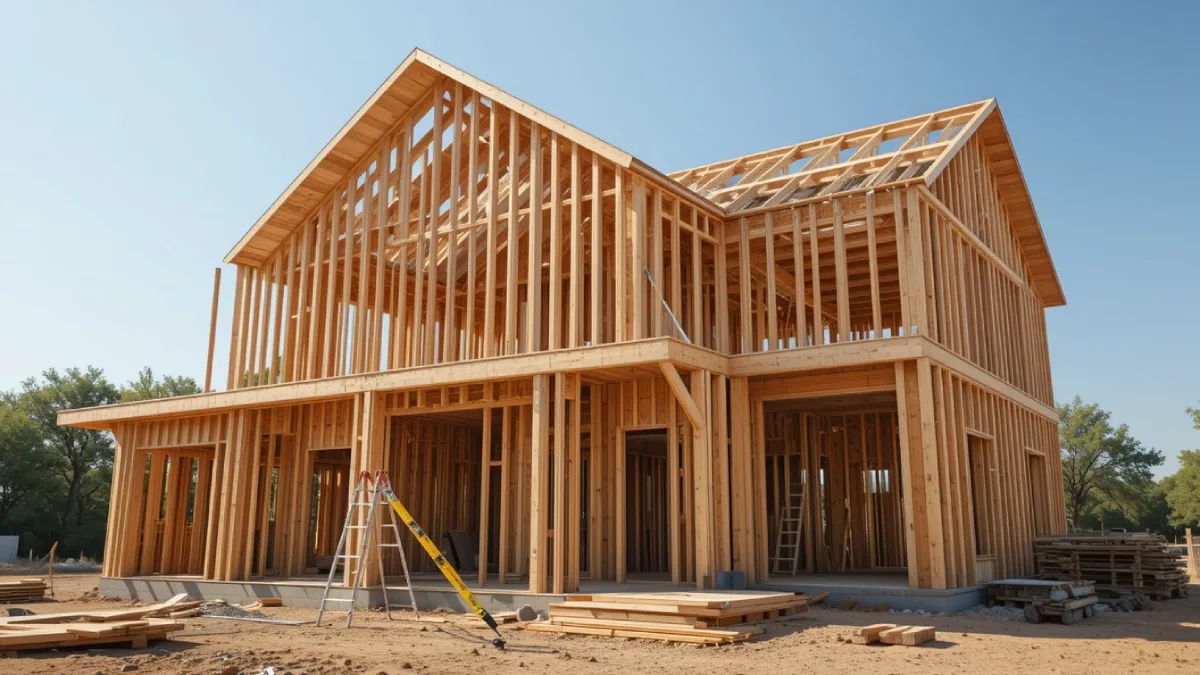Every home starts with a strong frame. It’s the base for everything that comes next. Think of framing as the skeleton of your house. Without it, nothing stands. Framing is key when building a house from the ground up.
Good framing supports your roof, walls, and floors and shapes how your home looks and feels. Whether you live in San Antonio or Austin, solid framing helps your house last longer and stand stronger. With extreme weather becoming more common, getting it right the first time is more important than ever. The better your frame, the safer your home.
What Is House Framing?
House framing is how builders create the structure of your home. They use wood or steel to form the floors, walls, and roof. Most homes use wood because it’s strong and affordable. But in some areas, steel offers extra protection against pests and moisture.
Framing follows a plan. Every wall, door, and window is mapped out. Construction framing companies use these plans to frame the house carefully and quickly. They make sure everything fits right. Accuracy is key here. One small mistake can throw off the whole build.
Meet Your Framing Experts
You can hire house framing contractors for this job. These pros understand safety rules and building codes. They make sure everything lines up and stays strong.
Framing contractors work fast, but they don’t cut corners. They use special tools to measure, cut, and place each board. Their work keeps your home safe and sturdy. And since they’re trained to spot problems early, you’ll avoid costly issues later.
Framing a House: Step-by-Step
Now let’s break it down. Here’s how the home framing process works from start to finish:
Step 1: Plan and Design
Every project starts with a plan and design. Builders look at blueprints that show the shape and size of your home and determine where walls, windows, and doors will go.
At this stage, it helps to involve construction framing companies. They can offer advice and spot issues before work begins, saving time and money later.
Step 2: Build the Foundation
A solid base is essential for framing a house. The crew pours a concrete slab, builds a crawl space, or digs a basement.
This step is vital. If your base isn’t level, your walls won’t be either. Foundation work must be solid. This is where foundation services come in. They ensure the frame has strong support underneath.
Step 3: Frame the Floor
Floor framing comes next. Contractors lay down floor joists. These are long wooden beams that support your floor.
They cover these with subflooring—a layer of plywood or OSB. This gives the house a flat, solid surface to build on, and a good floor frame keeps the rest of the structure stable.
Step 4: Frame the Walls
The team then frames the exterior and interior walls. They cut and assemble the wall sections on the ground, lifting and nailing them into place.
They also add openings for windows and doors, which need extra support to hold weight. Every wall must be straight, level, and strong. Wall framing services ensure these steps are done right.
Step 5: Frame the Roof
Once the walls are up, it’s time for the roof. Contractors may use rafters or roof trusses. These form the angles and shape of your roof.
Roof framing also includes the ridge board, which runs along the top. Roof framing services connect here to finish your home’s top. A well-framed roof protects against wind, rain, and sun.
Step 6: Sheathing and Wrap
Sheathing is a layer of wood panels attached to the walls and roof. It adds strength and protects your home from wind and water.
Then they cover the frame with a house wrap. This thin, tough layer stops moisture while letting the house breathe. A well-wrapped frame is key for energy savings and mold prevention.
How Long Does Framing Take?
The framing timeline depends on the size of the home and the speed of the crew. Most homes take 1–3 weeks to frame.
Bad weather can slow things down. But with skilled house framing contractors, the process moves fast. Framing may take a bit longer for large or custom homes.
Avoid These Common Framing Mistakes
Even small errors can cause big problems. Here are a few mistakes to avoid:
- Misaligned walls or corners
- Forgetting to plan space for wires or pipes
- Using the wrong lumber spacing
- Poor anchoring or bracing
- Rushing without proper measurements
That’s why it pays to hire pros. Construction framing companies know how to avoid these issues, and their experience helps them spot and fix problems early.
Why Texas Builders Use Professional Contractors
Builders in Texas choose professional contractors for a reason. They know the climate, the codes, and the challenges.
San Antonio, for example, gets hot and dry. Homes there need framing that can handle heat and shifting soil, and contractors help make that happen.
Austin also experiences a mix of rain and heat. Builders there frame homes to withstand both. Hiring experts can save you time, money, and stress.
How to Pick the Right Framing Crew
Here’s what to look for when hiring:
- Licensed and insured contractors
- Good reviews and referrals
- Clear timelines and price quotes
- Experience with your type of home
- Local knowledge of soil and weather
Don’t be afraid to ask questions. A good team will walk you through the process. You want a crew that communicates clearly and keeps the site clean.
Final Thoughts: Build It Right From the Start
Framing sets the tone for the whole house. A solid frame means a solid home. That’s why it’s worth working with top-notch framing experts.
Whether you’re building in Austin or San Antonio, start strong. Find skilled house framing contractors you trust. And always follow the proper steps.
Ready to build your dream home? Our team makes framing fast and stress-free.
Contact us today to get a free quote and expert advice. Let’s build something strong together!
FAQs:
You can, but it’s a tough job. Framing requires skill, strength, and precision. Most homeowners choose professional house framing contractors for better results.
Builders usually use 2×4 or 2×6 pine, fir, or spruce. These woods are strong, lightweight, and easy to cut for home framing projects.
Yes, most cities require permits before framing begins. You’ll also need inspections to ensure everything meets local building codes and safety standards.
Contractors use nail guns, circular saws, tape measures, and levels. These tools help them cut, connect, and align the wood quickly and accurately.
Look for licensed, insured contractors with strong local reviews. Ask about their experience, get quotes, and check if they’ve worked on similar home builds.

